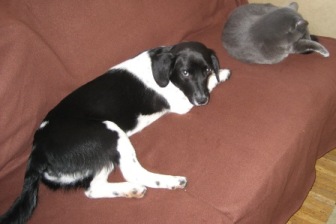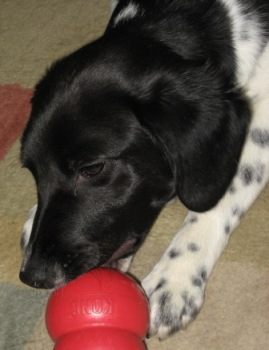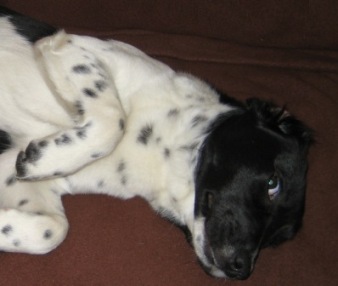I’ve adopted the dog.
Her name is Tessie now. Here are some pics!

I’m more than a little amazed that I happened upon a dog that meets my ideal so quickly. She’s the most agreeable little thing you could imagine, a total cuddler. Pretty much house trained from day one. She tends to be slightly on the cautious side but if you give her time to get used to something she comes around quickly.
Her only real “issue” is that she seems to be afraid of certain types of other dog (big ones)–we see them from time to time when we’re out on walks. But I’ve been using the “open bar” conditioning technique (I basically offer her treats by the handful the whole time the scary dog is in sight, so that she comes to associate seeing big dogs with positive things) and it’s having a visible effect: she will now calmly watch a dog on the other side of the street, where a week or two ago the encounter would leave her trembling and pulling to be taken back home.
I can only speculate as to the reason for her fear, but she did have a scab below her left eye and another on her neck when I first brought her home. I’m told that this isn’t unusual in rescue dogs: they are sometimes crowded together in runs with other dogs without consideration for whether the matches are appropriate. Fights break out, and dogs get hurt . . .

As a shelter dog, Tessie was also ignorant about things home-raised dogs take for granted. The most pervasive was that she had no idea, at first, that when I talk to her it means something. Finally after a couple of weeks she learned that “do you want to go for a walk?” is reason to get excited. But it was odd at first to realize that she was used to being around humans, but not being addressed by them.
It’s affected our obedience training, because she also has no framework for understanding that certain behaviors will earn rewards. I use clicker training for the basics and when I got my Corgi, I had her doing sits & downs within 48 hours. But with Tessie, progress is much slower. She tends to just stand perfectly still and study me–the notion that she can “earn” a treat is completely foreign to her. So I’m focusing, at this point, on showing her that “clickers & treats” is a fun game and that “doing stuff” is how a dog activates the human treat dispenser. I see some progress–she’s no longer a total statue during our games!
One other thing that I speculate is a consequence of her being a shelter dog: she seemed to have no concept of what it means to have space to let go and just run. I have a portion of my back yard fenced in; the first week or so, when I took her there and let her off leash, she just stood and looked around — if I walked the perimeter, she’d join me, at a walk, sniffing anything that smelled interesting on the way (she’s got that Beagle scent tracking gene for sure!)
Then, one day when I was out walking her on leash, she started giving these little hops, like some puppyish exuberance was starting to bubble out.

I took her to the yard, and let her off leash, and she ran full out for the first time, dashing to one end of the yard and then back again.
For another week or so, that was all she’d do. Then one day, something clicked — and now she’ll tear around that yard for as long as I’m content to hang out there with her. It’s a delight to watch! Pure puppy exuberance :-)

